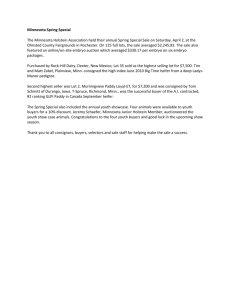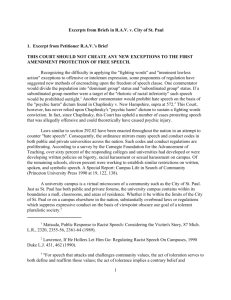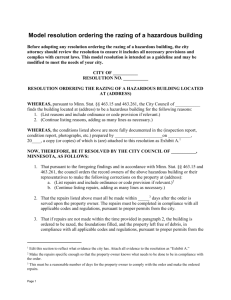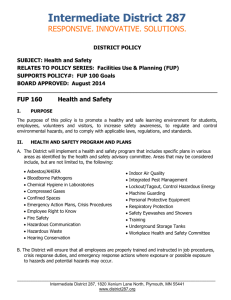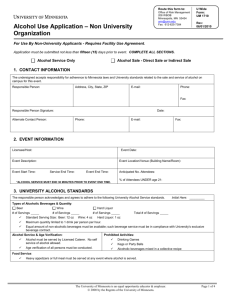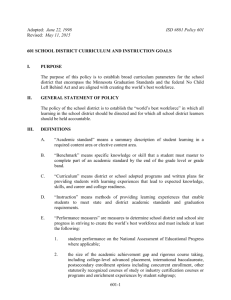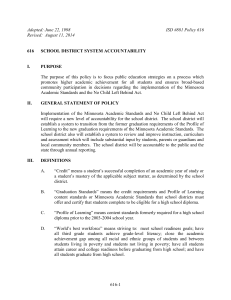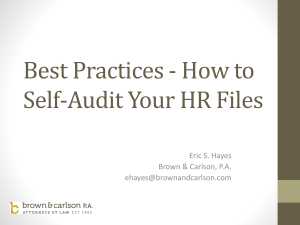Minnesota - Columbia Law School
advertisement
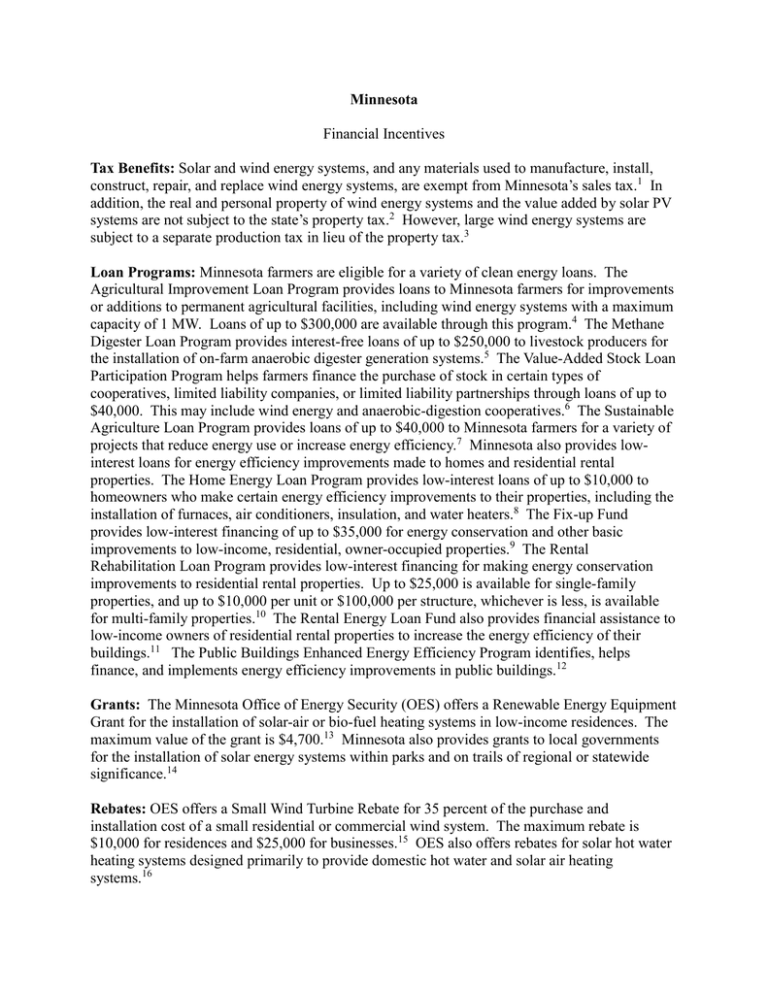
Minnesota Financial Incentives Tax Benefits: Solar and wind energy systems, and any materials used to manufacture, install, construct, repair, and replace wind energy systems, are exempt from Minnesota’s sales tax.1 In addition, the real and personal property of wind energy systems and the value added by solar PV systems are not subject to the state’s property tax.2 However, large wind energy systems are subject to a separate production tax in lieu of the property tax.3 Loan Programs: Minnesota farmers are eligible for a variety of clean energy loans. The Agricultural Improvement Loan Program provides loans to Minnesota farmers for improvements or additions to permanent agricultural facilities, including wind energy systems with a maximum capacity of 1 MW. Loans of up to $300,000 are available through this program.4 The Methane Digester Loan Program provides interest-free loans of up to $250,000 to livestock producers for the installation of on-farm anaerobic digester generation systems.5 The Value-Added Stock Loan Participation Program helps farmers finance the purchase of stock in certain types of cooperatives, limited liability companies, or limited liability partnerships through loans of up to $40,000. This may include wind energy and anaerobic-digestion cooperatives.6 The Sustainable Agriculture Loan Program provides loans of up to $40,000 to Minnesota farmers for a variety of projects that reduce energy use or increase energy efficiency.7 Minnesota also provides lowinterest loans for energy efficiency improvements made to homes and residential rental properties. The Home Energy Loan Program provides low-interest loans of up to $10,000 to homeowners who make certain energy efficiency improvements to their properties, including the installation of furnaces, air conditioners, insulation, and water heaters.8 The Fix-up Fund provides low-interest financing of up to $35,000 for energy conservation and other basic improvements to low-income, residential, owner-occupied properties.9 The Rental Rehabilitation Loan Program provides low-interest financing for making energy conservation improvements to residential rental properties. Up to $25,000 is available for single-family properties, and up to $10,000 per unit or $100,000 per structure, whichever is less, is available for multi-family properties.10 The Rental Energy Loan Fund also provides financial assistance to low-income owners of residential rental properties to increase the energy efficiency of their buildings.11 The Public Buildings Enhanced Energy Efficiency Program identifies, helps finance, and implements energy efficiency improvements in public buildings.12 Grants: The Minnesota Office of Energy Security (OES) offers a Renewable Energy Equipment Grant for the installation of solar-air or bio-fuel heating systems in low-income residences. The maximum value of the grant is $4,700.13 Minnesota also provides grants to local governments for the installation of solar energy systems within parks and on trails of regional or statewide significance.14 Rebates: OES offers a Small Wind Turbine Rebate for 35 percent of the purchase and installation cost of a small residential or commercial wind system. The maximum rebate is $10,000 for residences and $25,000 for businesses.15 OES also offers rebates for solar hot water heating systems designed primarily to provide domestic hot water and solar air heating systems.16 Other Financial Incentives: The Renewable Development Fund offers a production incentive of 1 to 1.5 cents per kWh generated by certain hydro facilities and anaerobic digesters.17 Xcel Energy is required by statute to fund and administer the Renewable Development Fund in proportion to the amount of nuclear waste it stores per year.18 In 2008, Xcel Energy contributed $19.5 million. This money must be spent on the development of renewable energy resources and research into renewable energy technology. Rules and Regulations Renewable Portfolio Standard: Minnesota’s RPS requires any utility that owned a nuclear generating facility as of January 1, 2007 to generate 30 percent of its total retail electricity sales from renewable sources by 2020. Only Xcel Energy is subject to this requirement. All other Minnesota utilities must generate 25 percent of their total retail electricity sales from renewable sources by 2025. Xcel Energy’s obligation increases incrementally as follows: 15 percent by 2010, 18 percent by 2012, 25 percent by 2016, and 30 percent by 2020. Other utilities must comply with the following schedule: 12 percent by 2012, 17 percent by 2016, 20 percent by 2020, and 25 percent by 2025. Eligible resources include solar thermal and PV, wind, hydrogen, small hydropower, landfill gas, anaerobic digestion, municipal solid waste, and other biomass. Of the 30 percent required of Xcel Energy in 2020, at least 25 percent must be generated by wind or solar. Of that 25 percent, no more than 1 percent may be generated by solar.19 In addition, Xcel Energy is specifically required by statute to operate, build or contract for 825 MW of wind generation capacity,20 as well as 110 MW of biomass.21 Facility Siting and Permitting: Local building officials may only issue permits for the installation of solar water-heating systems and solar space-heating systems which have been certified by the Solar Rating and Certification Corporation.22 Wind systems larger than 5 MW must receive a siting permit from the Minnesota Public Utilities Commission (MPUC) rather than comply with local land use rules.23 The MPUC has developed standardized siting rules for projects between 5 and 25 MW.24 Wind and solar projects of 50 MW or more must receive a Certificate of Need from the MPUC unless they are designed to meet the RPS and pass a reasonableness review.25 Minnesota law provides for the creation of solar and wind easements.26 Building Codes, Appliance, and Equipment Standards: Minnesota’s residential building code is based on the 2006 IRC27 and the commercial building code is based on ASHRAE 90.1-2004.28 Minnesota’s Departments of Administration and Commerce have issued Sustainable Building Guidelines for new construction and major renovations of state buildings, which are mandatory for all new buildings funded by state bond money as of 2004, and for all major renovations funded by state bond money as of 2009.29 Electricity Transmission, Interconnection and Storage: Qualifying facilities of less than 40 kW are eligible for net metering. Customers may receive actual payment or a credit towards their next billing period for NEG.30 The MPUC has established generic standards for utility tariffs for interconnection and the operation of DG systems up to 10 MW in capacity, including standard agreements for interconnection.31 Each public utility in Minnesota is also required to create a 20-year power purchase agreement for community-owned renewable energy projects.32 Fuel Standards and Transportation: All gasoline sold in Minnesota must contain at least 10 percent ethanol or the maximum percent of denatured ethanol the U.S. Environmental Protection Agency allows in all vehicles regardless of model year.33 Diesel fuel sold or offered for sale in the state for use in internal combustion engines must contain at least 5 percent biodiesel.34 Policies, Plans, and Governmental Affiliations Plans and Policies: Minnesota’s Next Generation Act of 2007 established a goal of reducing statewide GHG emissions 15 percent by 2015, 30 percent by 2025, and 80 percent by 2050, based on 2005 levels.35 Government Entities: Minnesota Department of Administration,36 Minnesota Department of Agriculture,37 Minnesota Department of Commerce,38 Minnesota Department of Natural Resources,39 Minnesota Department of Revenue,40 Minnesota Housing Finance Agency,41 Minnesota Office of Energy Security,42 Minnesota Pollution Control Agency,43 Minnesota Public Utilities Commission.44 Regional Memberships: Minnesota is a member of the MGGRA and the MGA. 1 Minn. Stat. § 297A.67, Subd. 29; Minn. Stat. § 297A.68, Subd. 12. Minn. Stat. § 272.02, Subd. 22 and Subd. 24. 3 Minn. Stat. § 272.028; Minn. Stat. § 272.029; H.F. No. 1298 (2009). 4 Minn. Stat. § 41B.043; Minn. Admin. Rules 1650.0601 et seq.; H.F. No. 1122 (2009); http://www.mda.state.mn.us/en/grants/loans/improvement.aspx. 5 Minn. Stat. § 41B.049; Minn. Stat. § 41B.03; http://www.mda.state.mn.us/grants/loans/digester.aspx. 6 Minn. Stat. § 41B.046; Minn. Admin. Rules 1656.0011 et seq.; http://www.mda.state.mn.us/en/grants/loans/stockloan.aspx. 7 Minn. Stat. § 17.115; http://www.mda.state.mn.us/en/grants/loans/esaploan.aspx. 8 http://bit.ly/9Vcd59. 9 http://www.mnhousing.gov/consumers/home-owners/HomeImprovementLoans/index.aspx. 10 http://www.mncee.org/programs_residential/rental_rehab_financing/mhfa_rental_rehab_pogram/index.php. 11 http://www.mncee.org/programs_residential/rental_rehab_financing/rental_energy_loan_fund/index.php. 12 http://www.pbeeep.org/. 13 http://www.state.mn.us/portal/mn/jsp/content.do?id=-536893809&subchannel=536895046&contentid=536917801&contenttype=EDITORIAL&programid=536917480&sp2=y&agency=Energy. 14 http://www.dnr.state.mn.us/grants/recreation/se_legacy.html. 15 http://www.state.mn.us/portal/mn/jsp/content.do?subchannel=536895045&programid=536917287&sc3=null&sc2=null&id=-536893809&agency=Energy. 16 http://www.state.mn.us/portal/mn/jsp/content.do?subchannel=536895046&programid=536917480&sc3=null&sc2=null&id=-536893809&agency=Energy. 17 Minn. Stat. § 216C.41. 18 Minn. Stat. § 116C.779; http://www.xcelenergy.com/rdf/. 19 Minn. Stat. § 216B.1691. 20 Minn. Stat. § 216B.2423. 21 Minn. Stat. § 216B.2424. 22 Minn. Stat. § 216C.25; Minn. Admin. Rules 1325.1100. 23 Minn. Stat. § 216F.01, Subd. 2; Minn. Stat. § 216F.07. 24 MPUC Order, Docket No. E,G-999/M-07-1102 (Jan. 11, 2008). 25 Minn. Stat. § 216B.243. 26 Minn. Stat. § 500.30. 2 27 Minn. Admin. Rules 1322.0010 et seq. Minn. Admin. Rules 1323.0001 et seq. 29 Minn. Stat. § 16B.325; http://www.msbg.umn.edu/. 30 Minn. Stat. § 216B.164; Minn. Admin. Rules 7835.3300; Minn. Admin. Rules 7835.9910. 31 Minn. Stat. § 216B.1611; MPUC Order, Docket No. E-999/CI-01-1023 (Sept. 28, 2004). 32 Minn. Stat. § 216B.1612. 33 Minn. Stat. § 239.791. 34 Minn. Stat. § 239.77. 35 S.F. No. 145 (2007). 36 http://www.admin.state.mn.us/. 37 http://www.mda.state.mn.us/. 38 http://www.commerce.state.mn.us/. 39 http://www.dnr.state.mn.us/. 40 http://taxes.state.mn.us/. 41 http://www.mnhousing.gov/. 42 http://www.state.mn.us/portal/mn/jsp/home.do?agency=Energy. 43 http://www.pca.state.mn.us/. 44 http://www.puc.state.mn.us/. 28
